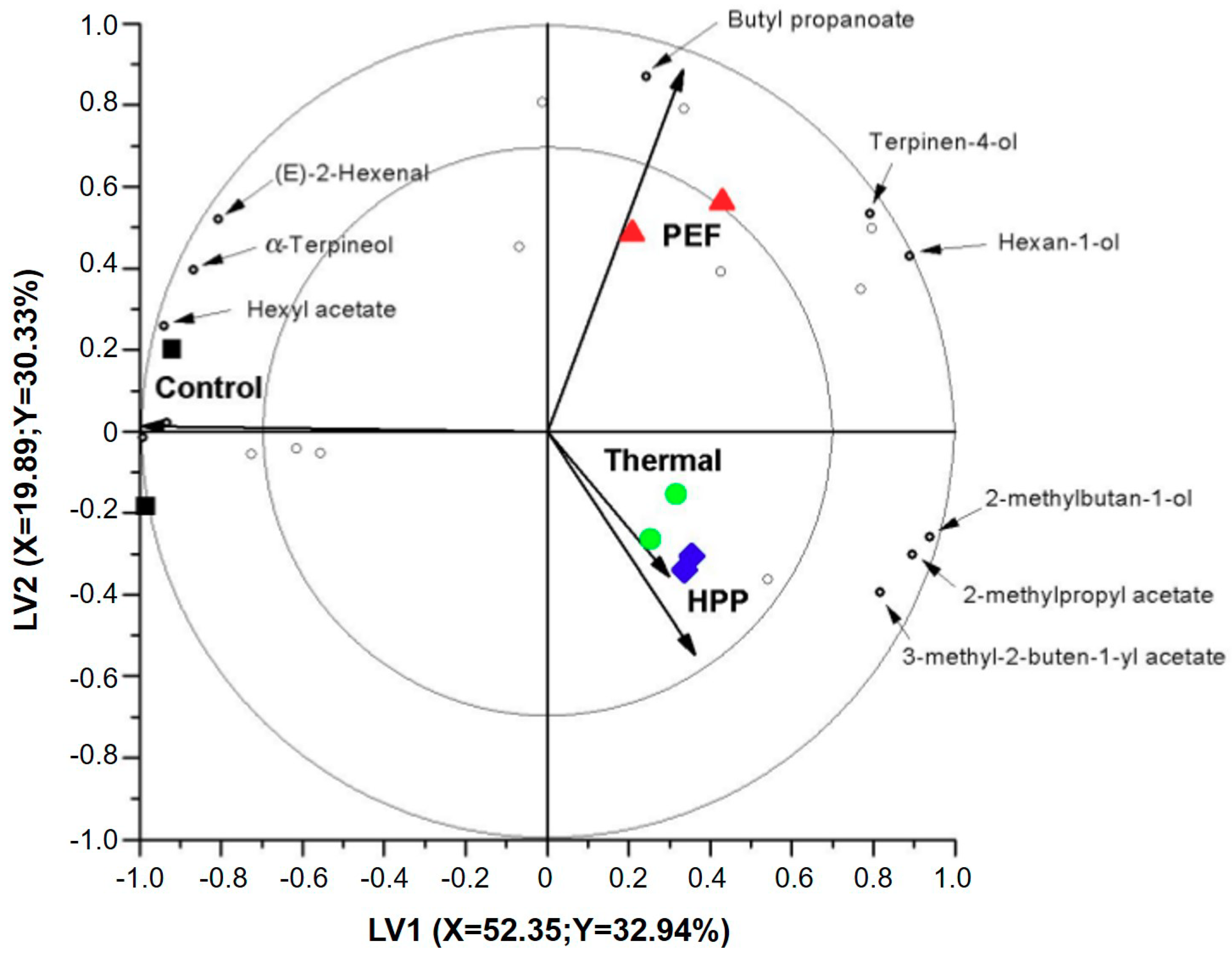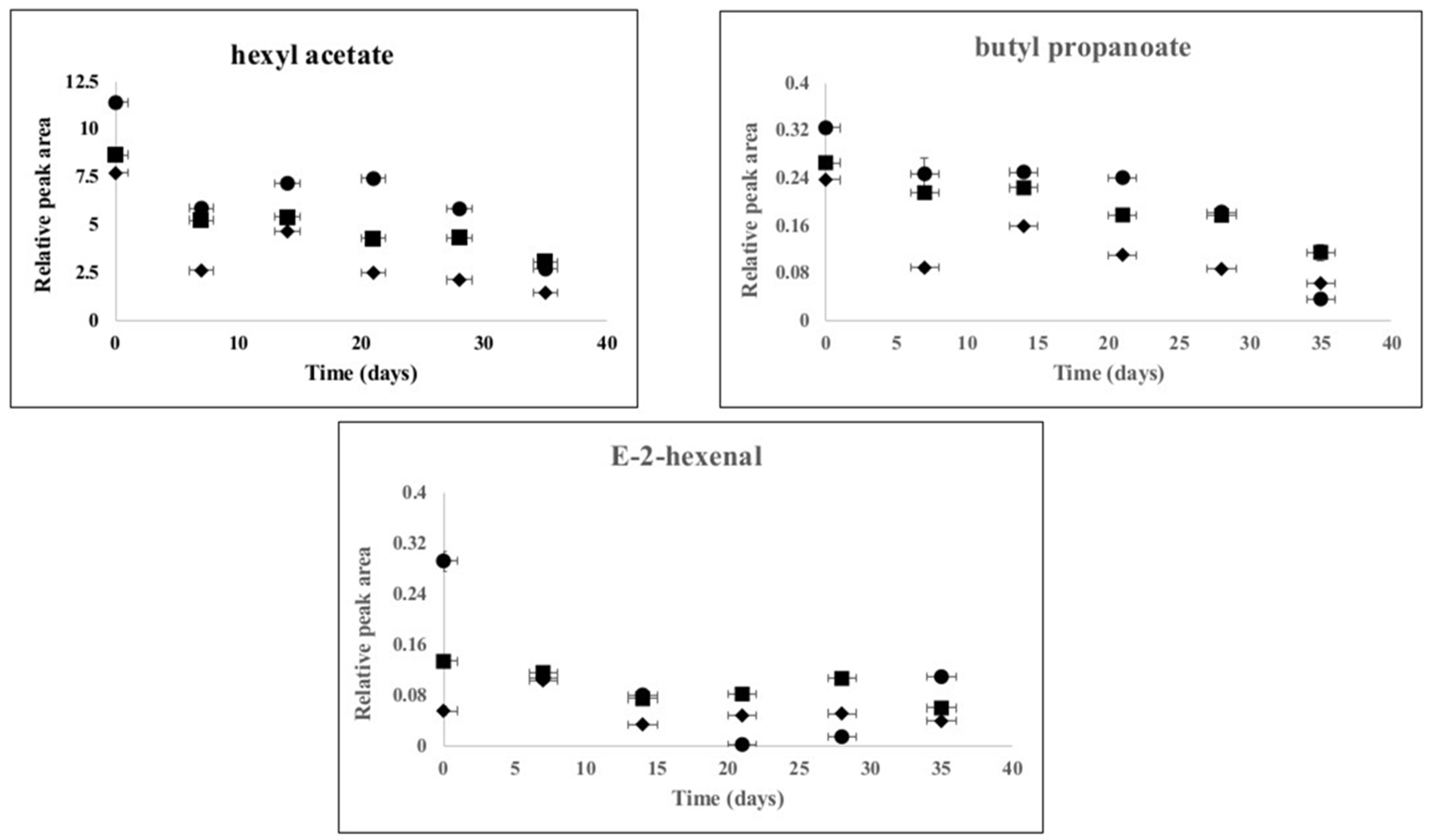A Chemometrics Approach Comparing Volatile Changes during the Shelf Life of Apple Juice Processed by Pulsed Electric Fields, High Pressure and Thermal Pasteurization
Abstract
:1. Introduction
2. Materials and Methods
2.1. Sample Preparation
2.2. Sample Pasteurization
2.3. Storage
2.4. Volatile Analysis
2.5. Data Analysis: Multivariate Data Analysis
3. Results and Discussion
3.1. Process Impact Comparison Immediately after Processing
3.2. Effect of Refrigerated Storage
4. Conclusions
Author Contributions
Funding
Acknowledgments
Conflicts of Interest
References
- Knorr, D.; Froehling, A.; Jaeger, H.; Reineke, K.; Schlueter, O.; Schoessler, K. Emerging technologies in food processing. Annu. Rev. Food Sci. Technol. 2011, 2, 203–235. [Google Scholar] [CrossRef] [PubMed]
- Mujica-Paz, H.; Valdez-Fragoso, A.; Samson, C.T.; Welti-Chanes, J.; Torres, J.A. High-pressure processing technologies for the pasteurization and sterilization of foods. Food Bioprocess Technol. 2011, 4, 969–985. [Google Scholar] [CrossRef]
- Picouet, P.A.; Hurtado, A.; Jofre, A.; Banon, S.; Ros, J.M.; Guardia, M.D. Effects of thermal and high-pressure treatments on the microbiological, nutritional and sensory quality of a multi-fruit smoothie. Food Bioprocess Technol. 2016, 9, 1219–1232. [Google Scholar] [CrossRef]
- Hicks, D.T.; Pivarnik, L.F.; McDermott, R.; Richard, N.; Hoover, D.G.; Kniel, K.E. Consumer awareness and willingness to pay for high-pressure processing of ready-to-eat food. J. Food Sci. Educ. 2009, 8, 32–38. [Google Scholar] [CrossRef]
- Frewer, L.J.; Bergmann, K.; Brennan, M.; Lion, R.; Meertens, R.; Rowe, G.; Siegrist, M.; Vereijken, C. Consumer response to novel agri-food technologies: Implications for predicting consumer acceptance of emerging food technologies. Trends Food Sci. Technol. 2011, 22, 442–456. [Google Scholar] [CrossRef]
- Oey, I.; Lille, M.; Van Loey, A.; Hendrickx, M. Effect of high-pressure processing on colour, texture and flavour of fruit- and vegetable-based food products: A review. Trends Food Sci. Technol. 2008, 19, 320–328. [Google Scholar] [CrossRef]
- Oey, I.; Van der Plancken, I.; Van Loey, A.; Hendrickx, M. Does high pressure processing influence nutritional aspects of plant based food systems? Trends Food Sci. Technol. 2008, 19, 300–308. [Google Scholar] [CrossRef]
- Sotelo, K.; Hamid, N.; Oey, I.; Gutierrez-Maddox, N.; Ma, Q.; Leong, S.Y. Effect of pulsed electric fields on the flavour profile of red-fleshed sweet cherries (Prunus avium var. Stella). Molecules 2015, 20, 5223–5238. [Google Scholar] [CrossRef] [PubMed]
- Yi, J.J.; Kebede, B.T.; Dang, D.N.H.; Buve, C.; Grauwet, T.; Van Loey, A.; Hu, X.S.; Hendrickx, M. Quality change during high pressure processing and thermal processing of cloudy apple juice. LWT-Food Sci. Technol. 2017, 75, 85–92. [Google Scholar] [CrossRef]
- Keenan, D.F.; Brunton, N.P.; Gormley, T.R.; Butler, F.; Tiwari, B.K.; Patras, A. Effect of thermal and high hydrostatic pressure processing on antioxidant activity and colour of fruit smoothies. Innov. Food Sci. Emerg. Technol. 2010, 11, 551–556. [Google Scholar] [CrossRef]
- Briones-Labarca, V.; Venegas-Cubillos, G.; Ortiz-Portilla, S.; Chacana-Ojed, M.; Maureira, H. Effects of high hydrostatic pressure (HHP) on bioaccessibility, as well as antioxidant activity, mineral and starch contents in Granny Smith apple. Food Chem. 2011, 128, 520–529. [Google Scholar] [CrossRef] [PubMed]
- Aguillar-Rosas, S.F.; Ballinas-Casarrubias, M.L.; Nevarez-Moorillon, G.V.; Martin-Belloso, O.; Ortega-Rivas, E. Thermal and pulsed electric fields pasteurization of apple juice: Effects on physicochemical properties and flavour compounds. J. Food Eng. 2007, 83, 41–46. [Google Scholar] [CrossRef]
- Landl, A.; Abadias, M.; Sárraga, C.; Viñas, I.; Picouet, P.A. Effect of high pressure processing on the quality of acidified Granny Smith apple purée product. Innov. Food Sci. Emerg. Technol. 2010, 11, 557–564. [Google Scholar] [CrossRef]
- Nikfardjam, M.P.; Maier, D. Development of a headspace trap HRGC/MS method for the assessment of the relevance of certain aroma compounds on the sensorial characteristics of commercial apple juice. Food Chem. 2011, 126, 1926–1933. [Google Scholar] [CrossRef] [PubMed]
- Komthong, P.; Igura, N.; Shimoda, M. Effect of ascorbic acid on the odours of cloudy apple juice. Food Chem. 2007, 100, 1342–1349. [Google Scholar] [CrossRef]
- Aprea, E.; Corollaro, M.L.; Betta, E.; Endrizzi, I.; Demattè, M.L.; Biasiol, F.; Gasperi, F. Sensory and instrumental profiling of 18 apple cultivars to investigate the relation between perceived quality and odour and flavour. Food Res. Int. 2012, 49, 677–686. [Google Scholar] [CrossRef]
- Dixon, J.; Hewett, E.W. Factors affecting apple aroma/flavour volatile concentration: A review. N. Z. J. Crop Hortic. Sci. 2000, 28, 155–173. [Google Scholar] [CrossRef]
- Grauwet, T.; Vervoort, L.; Colle, I.; Van Loey, A.; Hendrickx, M. From fingerprinting to kinetics in evaluating food quality changes. Trends Biotechnol. 2014, 32, 125–131. [Google Scholar] [CrossRef] [PubMed] [Green Version]
- Vervoort, L.; Grauwet, T.; Kebede, B.T.; Van der Plancken, I.; Timmermans, R.; Hendrickx, M.; Van Loey, A. Headspace fingerprinting as an untargeted approach to compare novel and traditional processing technologies: A case-study on orange juice pasteurisation. Food Chem. 2012, 134, 2303–2312. [Google Scholar] [CrossRef] [PubMed]
- Kebede, B.T.; Grauwet, T.; Palmers, S.; Vervoort, L.; Carle, R.; Hendrickx, M.; Van Loey, A. Effect of high pressure high temperature processing on the volatile fraction of differently coloured carrots. Food Chem. 2014, 153, 340–352. [Google Scholar] [CrossRef] [PubMed]
- Kebede, B.T.; Grauwet, T.; Tabilo-Munizaga, G.; Palmers, S.; Vervoort, L.; Hendrickx, M.; Van Loey, A. Headspace components that discriminate between thermal and high pressure high temperature treated green vegetables: Identification and linkage to possible process-induced chemical changes. Food Chem. 2013, 141, 1603–1613. [Google Scholar] [CrossRef] [PubMed]
- Kebede, B.T.; Grauwet, T.; Palmers, S.; Michiels, C.; Hendrickx, M.; Van Loey, A. Investigating chemical changes during shelf-life of thermal and high-pressure high-temperature sterilised carrot purees: A ‘fingerprinting kinetics’ approach. Food Chem. 2015, 185, 119–126. [Google Scholar] [CrossRef] [PubMed] [Green Version]
- Lee, P.Y.; Lusk, K.; Mirosa, M.; Oey, I. Effect of information on Chinese consumers’ acceptance of thermal and non-thermal treated apple juices: A study of young Chinese immigrants in New Zealand. Food Qual. Prefer. 2016, 48, 118–129. [Google Scholar] [CrossRef]
- Lee, P.Y.; Kebede, B.T.; Lusk, K.; Mirosa, M.; Oey, I. Investigating consumers’ perception of apple juice as affected by novel and conventional processing technologies. Int. J. Food Sci. Technol. 2017, 52, 2564–2571. [Google Scholar] [CrossRef]
- López, M.L.; Villatoro, C.; Fuentes, T.; Graell, J.; Lara, I.; Echeverría, G. Volatile compounds, quality parameters and consumer acceptance of ‘Pink Lady®’ apples stored in different conditions. Postharvest Biol. Technol. 2007, 43, 55–66. [Google Scholar] [CrossRef]
- Yahia, E.M. Apple flavor. Hort. Rev. 2010, 16, 197–234. [Google Scholar]




| Processing | VID | Identity | RI |
|---|---|---|---|
| Control/Unprocessed | −0.932 | 2-methylbutan-1-ol | 732 |
| −0.886 | 2-methylpropyl acetate | 965 | |
| −0.882 | hexan-1-ol | 869 | |
| −0.809 | 3-methyl-2-buten-1-yl acetate | 919 | |
| 0.820 | (E)-2-hexenal | 851 | |
| 0.880 | α-terpineol | 1199 | |
| 0.950 | hexyl acetate | 1010 | |
| Thermal (72 °C for 15 s) | −0.812 | (E)-2-hexenal | 851 |
| −0.801 | α-terpineol | 1199 | |
| HPP (600 MPa for 3 min) | 0.836 | 2-methylbutyl acetate | 877 |
| PEF (15.5 kV/cm) | 0.824 | hexan-1-ol | 869 |
| 0.831 | butyl propanoate | 906 | |
| 0.849 | terpinen-4-ol | 1185 |
| Processing | VID | Identity | RI |
|---|---|---|---|
| Thermal (72 °C for 15 s) | −0.954 | 3-methyl-2-buten-1-yl acetate | 919 |
| −0.951 | pentyl acetate | 911 | |
| −0.948 | 2-methylpropyl butanoate | 943 | |
| HPP (600 MPa for 3 min) | −0.971 | butyl propanoate | 906 |
| −0.970 | pentyl acetate | 911 | |
| −0.938 | ethyl 2-methylbutanoate | 896 | |
| −0.920 | hexyl acetate | 1010 | |
| −0.841 | (E)-2-hexenal | 851 | |
| PEF (15.5 kV/cm) | −0.939 | butyl propanoate | 906 |
| −0.878 | ethyl 2-methylbutanoate | 896 | |
| −0.858 | hexyl acetate | 1010 | |
| −0.831 | hexanal | 797 |
© 2018 by the authors. Licensee MDPI, Basel, Switzerland. This article is an open access article distributed under the terms and conditions of the Creative Commons Attribution (CC BY) license (http://creativecommons.org/licenses/by/4.0/).
Share and Cite
Kebede, B.; Lee, P.Y.; Leong, S.Y.; Kethireddy, V.; Ma, Q.; Aganovic, K.; Eyres, G.T.; Hamid, N.; Oey, I. A Chemometrics Approach Comparing Volatile Changes during the Shelf Life of Apple Juice Processed by Pulsed Electric Fields, High Pressure and Thermal Pasteurization. Foods 2018, 7, 169. https://doi.org/10.3390/foods7100169
Kebede B, Lee PY, Leong SY, Kethireddy V, Ma Q, Aganovic K, Eyres GT, Hamid N, Oey I. A Chemometrics Approach Comparing Volatile Changes during the Shelf Life of Apple Juice Processed by Pulsed Electric Fields, High Pressure and Thermal Pasteurization. Foods. 2018; 7(10):169. https://doi.org/10.3390/foods7100169
Chicago/Turabian StyleKebede, Biniam, Pui Yee Lee, Sze Ying Leong, Vidya Kethireddy, Qianli Ma, Kemal Aganovic, Graham T. Eyres, Nazimah Hamid, and Indrawati Oey. 2018. "A Chemometrics Approach Comparing Volatile Changes during the Shelf Life of Apple Juice Processed by Pulsed Electric Fields, High Pressure and Thermal Pasteurization" Foods 7, no. 10: 169. https://doi.org/10.3390/foods7100169









